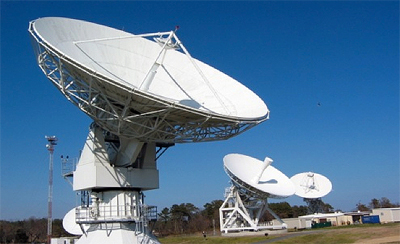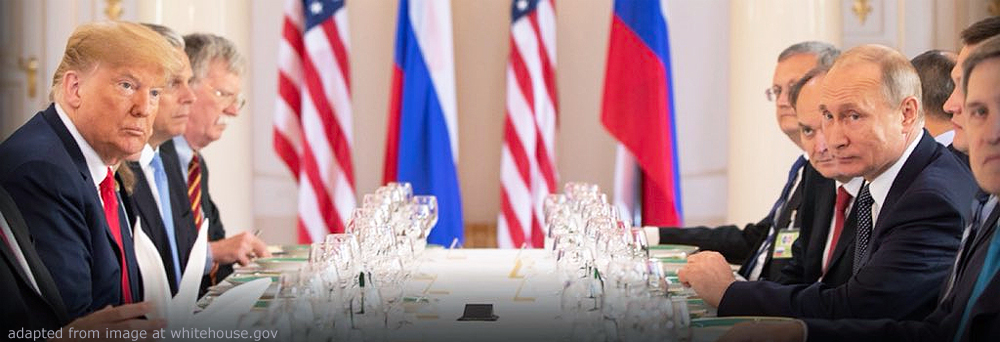Trump Bump and Trump Filter Bubble: How the media’s obsession with Trump may encourage the Russian propaganda machine

(Kennan Institute – wilsoncenter.org/program/kennan-institute – Andrey Miroshnichenko, Sergei Samoilenko – July 27, 2018)
Andrey Miroshnichenko, is a Ph.D. student in communication and culture at York University, Toronto. Sergei Samoilenko is professor in the Communication department at George Mason University.
[Text with links: kennan-russiafile.org/2018/07/27/trump-bump-and-trump-filter-bubble-how-the-medias-obsession-with-trump-may-encourage-the-russian-propaganda-machine/]
The recent Helsinki summit put U.S.- Russia relations back in the headlines. The critical coverage of the meeting with Vladimir Putin seem to have caused little damage to Trump, but played directly into Russia’ advantage. Undoubtedly, Moscow has been historically among the most influential actors for American politics, but this time Russia’s heightened media presence should be largely accounted to the efforts of the media themselves.
News coverage of Trump has not only been important for democracy, it has also been highly profitable for the media. This has trapped both the media and the audience in a Trump filter bubble that has had a greater impact on politics than Trump himself.
Fighting Trump, Enjoying the Trump Bump
The period since the 2016 election has seen a huge increase in readership and viewership for the leading American media, the so-called Trump bump. The New Yorker, the Atlantic, and the Washington Post saw a doubling or tripling of subscriptions. For CNN, 2016 was the most profitable year in the organization’s history. Shows and TV hosts that focused heavily on Trump received a ratings boost. But the leading symbol of the Trump bump is Trump’s nemesis, the New York Times. As of December 2017, the Gray Lady had 2,231,000 digital subscribers for its news product, setting a world record.
What drove the Trump bump in the media? Many Americans wanted to support the media in their crusade against Trumpism and fake news. The progressive public also sought an explanation and emotional compensation for the shock over Trump’s election.
The media seized the moment and began promoting their role as saviors of democracy. They also began to pump out Trump-related stories to keep the audience engaged. As the old reporter’s adage goes, “If it bleeds, it leads.” An appropriate contemporary updating might be “If it’s Trump, it leads.” (The Columbia Journalism Review reports that placing international stories at American outlets is getting harder, unless they directly involve Trump.)
Comedian Michelle Wolf made this point at the White House Correspondents’ Dinner on April 28, 2018, “He’s helped you sell your papers and your books and your TV. You helped create this monster, and now you’re profiting off of him.”
The same goes for book publishing. In 2018, as noticed by Brian Stelter, each book at the top of the New York Times best-seller list has had one thing in common: President Trump.
In a free-market economy, character assassination in the media has intrinsic commodity value. Unsurprisingly, negativity is quite profitable for both political camps in the United States. The point is that stories assassinating Trump’s character are lucrative regardless of whether they are true or manipulative.
Much of this success for American media can be attributed to Donald Trump himself. A “very stable genius” of publicity, the American president constantly generates news leads, helping sustain the Trump bump.
The Trump card in the game against the internet
Subscription growth was not the only reason for the traditional media to focus on Donald Trump. The investigation of Trump’s victory gave traditional media a perfect-and perhaps its last-opportunity to fight back against the internet giants.
The Google-Facebook duopoly continues to win over content, audience, and the advertising market. However, in the thicket of fake news stories and Russia-related scandals, internet platforms felt vulnerable for the first time. The situation has the potential to rein in internet platforms and shore up the historical role of the traditional media, restoring their position and increasing public and legislative support.
All in all, for the media, Trumpism has proved to be a commodity in high demand. When the best media professionals look for developing of a hot topic, they will not only dig it out but also frame it at its best. The strength of journalism is that it can make the significant interesting, but more often journalism makes the interesting significant. A good example of it is the theme of “Russian meddling.”
The Trump Filter Bubble
Russian meddling is one of the most successful themes in Trump media coverage because it draws in many interests.
The traditional media were not the only party interested in linking Trump’s victory to Russia’s efforts-the progressive public was also concerned. For this audience, the “Russian” explanation allows bypassing discussion of why 63 million Americans did not share its values.
For the Democrats, the Russian frame helps keep Trump under constant political and legal pressure, with the potential to jeopardize Trump’s entire presidency. Strange as it may seem, the “Russian meddling” narrative may also prove beneficial for internet platforms. The scandal has ensured the public that 120 Facebook pages affected the opinions of 146 million Americans. No other media channel in history can demonstrate such efficiency. Indeed, despite the scandals surrounding their operations, Facebook, Google, and Twitter saw record earnings in the first quarter of 2018.
Finally, the story about almighty Russia, powerful enough to change the outcome of an American election (if only by after-the-fact suggestion), can only please the Russian regime. When Obama called Russia a “regional power” in 2014, it was a huge insult to the Kremlin. Today the Kremlin can be satisfied with America’s changing attitudes toward Russia’s gravitas.
To a Man with a Hammer, Everything Looks Like a Nail
For Russian propagandists, the media portrayal of their significant impact on the American election with such low investment is like winning the lottery. Just a few years ago, media experts in Russia mocked the TV company Russia Today for its claims about competing with Al Jazeera. Last fall, Margarita Simonyan, RT’s chief, was ranked 52nd on Forbes’s list of the world’s most powerful women. Trump has made great not only the American media but some Russian ones, too-contrary to all their expectations.
The Russian propaganda machine, convinced by American media of its own omnipotence, may start seeking new ways to secure its prestige and funding. However, this machine is unlikely to cause any significant harm to its targets. Its effectiveness is overblown inside the Trump filter bubble.
In addition, from now on, the progressive American public and the media, including all watchdogs and fact-checkers, will thoroughly monitor and scrutinize any online activity, alert to any attempts at a coordinated malicious campaign. The only outcome of ramping up propaganda efforts would be a new round of conflict.
The Media’s Burden
For the political system, the Trump filter bubble is a more substantial problem than fake news or outside malicious influence, since it strengthens polarization. Ultimately it is polarization that makes people susceptible to fake news and malicious outside influences.
There is already an example in American history of the media’s pursuit of readership contributing to a real war. William R. Hearst and Joseph Pulitzer exploited tensions between the United States and Spain to boost circulation of their newspapers, a factor in the outbreak of the Spanish-American War in 1898.
Of course, the media alone do not bear the full brunt of responsibility for the current state of affairs in American politics. But the media’s coverage of Trump is driven in part by some specific commercial motives that for the most part are unnoticed by the public. In the other circumstances, actors with such a powerful influence would be obliged to disclose what amounts to a conflict of interest.

